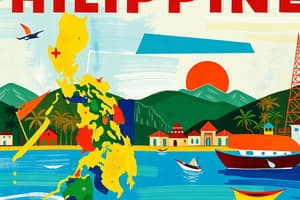Podcast
Questions and Answers
What is a significant benefit of cultural tourism in the Philippines?
What is a significant benefit of cultural tourism in the Philippines?
- It solely focuses on historical artifacts.
- It hinders local economic development.
- It enhances understanding of diverse cultural identity. (correct)
- It limits interactions among different cultures.
Which region in the Philippines is known for its colonial architecture and is a UNESCO World Heritage Site?
Which region in the Philippines is known for its colonial architecture and is a UNESCO World Heritage Site?
- Davao
- Cebu
- Metro Manila
- Ilocos Region (correct)
Which festival is associated with the cultural expression in the Visayas region?
Which festival is associated with the cultural expression in the Visayas region?
- Ati-Atihan Festival
- Sinulog Festival (correct)
- Kadayawan Festival
- Panagbenga Festival
What is an example of a challenge faced by cultural tourism in the Philippines?
What is an example of a challenge faced by cultural tourism in the Philippines?
Which cultural element showcases local narratives through handmade items?
Which cultural element showcases local narratives through handmade items?
What aspect of local communities is crucial in maximizing the benefits of cultural tourism?
What aspect of local communities is crucial in maximizing the benefits of cultural tourism?
Which of the following regions is known for its indigenous cultures and unique rice terraces?
Which of the following regions is known for its indigenous cultures and unique rice terraces?
What is an important aspect of Philippine cuisine that is highlighted in cultural tourism?
What is an important aspect of Philippine cuisine that is highlighted in cultural tourism?
Study Notes
Overview of Philippine Cultural Tourism Geography
- Cultural Tourism: Involves the exploration of cultural heritage, traditions, and local lifestyles.
- Significance: Enhances understanding of the Philippines' diverse cultural identity and contributes to local economies.
Key Regions and Cultural Highlights
-
Luzon
- Metro Manila: Historical sites (Intramuros), museums, festivals.
- Cordillera: Indigenous cultures, rice terraces, tribal festivals.
- Ilocos Region: Colonial architecture, Vigan (UNESCO World Heritage Site), traditional crafts.
-
Visayas
- Cebu: Historical sites (Magellan's Cross), Sinulog Festival.
- Bohol: Chocolate Hills, Tarsier Sanctuary, local handicrafts.
- Negros: Sugar plantation heritage, local festivals.
-
Mindanao
- Davao: Mount Apo, cultural diversity, Kadayawan Festival.
- Zamboanga: Badjao culture, colorful vinta boats.
- Basilan and Sulu: Rich Islamic heritage, traditional music and dance.
Cultural Elements
- Festivals: Key for cultural expression; examples include Ati-Atihan, Pahiyas, and Panagbenga.
- Cuisine: Regional dishes reflecting local ingredients and influences (e.g., adobo, sinigang, lechon).
- Arts and Crafts: Traditional weaving, pottery, painting; local artisans often reflect cultural narratives.
Challenges and Opportunities
- Sustainable Tourism: Balancing tourism development with the preservation of culture and heritage.
- Community Involvement: Engaging local communities in tourism planning and benefits.
- Infrastructure Development: Improving access to cultural sites while maintaining their integrity.
Conclusion
- The diverse geography of the Philippines plays a vital role in its cultural tourism, offering a rich tapestry of experiences that reflect the nation's history, traditions, and vibrant communities.
Overview of Philippine Cultural Tourism Geography
- Cultural tourism encompasses the exploration of cultural heritage, traditions, and lifestyles.
- Important for enhancing the understanding of the Philippines' diverse cultural identity.
- Contributes significantly to local economies by attracting tourists.
Key Regions and Cultural Highlights
-
Luzon:
- Metro Manila features historical sites like Intramuros, alongside numerous museums and vibrant festivals.
- Cordillera is known for its indigenous cultures and rice terraces, hosting various tribal festivals.
- Ilocos Region showcases colonial architecture, particularly Vigan, a UNESCO World Heritage Site, and is known for traditional crafts.
-
Visayas:
- Cebu is home to historical landmarks such as Magellan's Cross and the famous Sinulog Festival.
- Bohol is recognized for its natural wonders, including the Chocolate Hills and Tarsier Sanctuary, plus an emphasis on local handicrafts.
- Negros highlights its sugar plantation heritage, underpinning local cultural festivals.
-
Mindanao:
- Davao boasts Mount Apo, the highest peak in the Philippines, with a rich blend of cultural diversity and the Kadayawan Festival celebrating local heritage.
- Zamboanga is notable for the Badjao culture and vibrant vinta boats.
- Basilan and Sulu exhibit a profound Islamic heritage, featuring traditional music and dance.
Cultural Elements
- Festivals play a critical role in cultural expression, with key examples including Ati-Atihan, Pahiyas, and Panagbenga.
- Philippine cuisine highlights regional dishes that showcase local ingredients and cultural influences, such as adobo, sinigang, and lechon.
- Arts and crafts feature traditional practices like weaving, pottery, and painting, often telling cultural narratives through the work of local artisans.
Challenges and Opportunities
- Sustainable tourism aims to balance the development of the tourism sector with the preservation of culture and heritage.
- Community involvement is essential in engaging local populations in tourism planning and ensuring they benefit from its growth.
- Infrastructure development focuses on enhancing access to cultural sites while maintaining their historical and cultural integrity.
Conclusion
- The Philippines' diverse geography is crucial for its cultural tourism, offering a rich array of experiences that reflect the nation's history, traditions, and vibrant communities.
Studying That Suits You
Use AI to generate personalized quizzes and flashcards to suit your learning preferences.
Description
Explore the rich cultural tourism landscape of the Philippines through its key regions. This quiz focuses on the diverse heritage of Luzon, Visayas, and Mindanao, highlighting historical sites, festivals, and local crafts that define Philippine culture. Discover how these elements contribute to understanding the nation's identity and boosting local economies.




